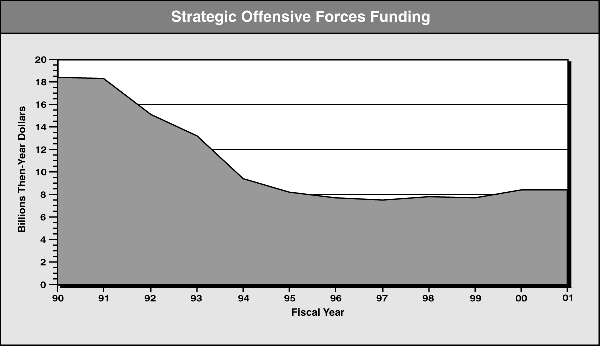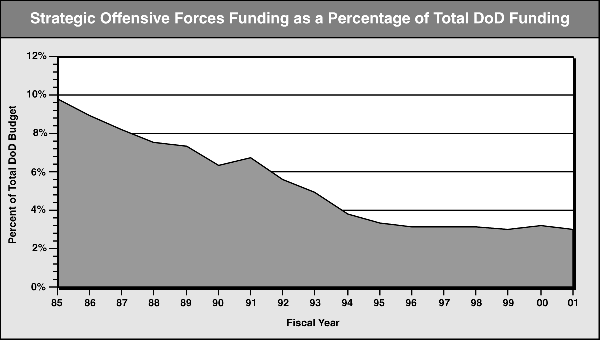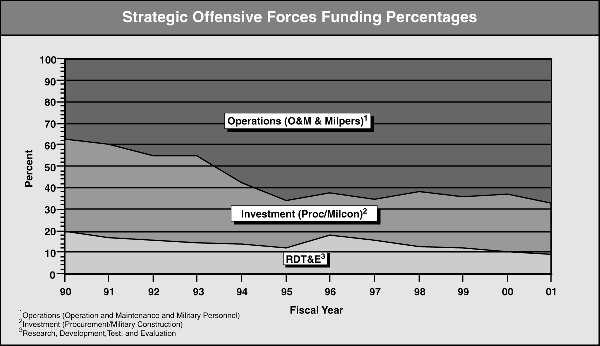
 DOD Doctrine
DOD DoctrineThe mission of U.S. strategic nuclear forces is to deter a nuclear attack on the United States or its vital interests and to convince potential adversaries with access to nuclear weapons that seeking a nuclear advantage would be futile. In order to do this, the United States must maintain nuclear forces of sufficient size and capability to hold at risk a broad range of assets valued by potentially hostile nations.
The threat of a massive nuclear attack on the United States is much lower today than it has been in more than 40 years. Several developments have given rise to this situation, including the dissolution of the Soviet Union and Warsaw Pact, the recent entry into force of the Strategic Arms Reduction Talks (START) I Treaty and the expected future implementation of START II, and improved relations with Russia. Still, approximately 25,000 nuclear weapons continue to be deployed in Russia and on the territories of three other former Soviet republics. And even under START II, Russia will retain a sizable nuclear arsenal. Moreover, the future political situation in Russia remains highly uncertain. In addition, China is growing militarily and economically and has the potential to increase the size and capability of its strategic nuclear arsenal significantly over the next decade. Finally, several countries are attempting to acquire technology for nuclear weapons, medium- to long-range nuclear-capable missiles, or both. There is, therefore, a risk that potentially hostile nations could acquire a limited capability for long-range delivery of nuclear weapons in the next decade.
Two basic requirements thus guide U.S. planning for strategic nuclear forces: the need to provide an effective deterrent while conforming to treaty limitations, and the need to be able to reconstitute adequate additional forces in a timely manner should the positive trends in post-Cold War international relations be reversed.
FORCE STRUCTURE AND CAPABILITIES
Assuming that START II is implemented, the U.S. strategic nuclear arsenal by the year 2003 is expected to include approximately the following:
By the late 1990s, the entire force of B-1B bombers is expected to be dedicated to conventional missions. While these aircraft would not be available for nuclear missions on short notice, given sufficient time and the requirement to do so, they could be returned to a nuclear role. The B-2 and B-52H forces also will be assigned conventional missions, while retaining their existing responsibilities as part of the U.S. nuclear deterrent.
Land-Based Intercontinental Ballistic Missiles
At the end of FY 1995, the U.S. land-based intercontinental ballistic missile (ICBM) force will consist of 530 Minuteman III ICBMs with three warheads each, 50 Peacekeeper ICBMs carrying 10 warheads apiece, and about five single-warhead Minuteman II ICBMs. The last Minuteman II will be retired in FY 1996. Assuming START II enters into force, the number of Minuteman III missiles will decline to between 450 and 500 and all of these missiles will be modified to carry only one warhead each. With implementation of the START II Treaty, the United States will eliminate the Peacekeeper system by the year 2003.
The Department is preserving the option to transfer the Mark 21 warhead from the Peacekeeper to the Minuteman system. The Mark 21 was identified as the safest U.S. nuclear warhead by the Drell Commission, which was established by Congress to investigate the potential hazards associated with handling, transporting, and deploying U.S. nuclear warheads. Mark 21 warheads contain several safety-enhancing features that are designed to reduce the risk of an accidental nuclear explosion and prevent molten plutonium from leaking outside the warhead in the event of a fire.
A significant challenge in future planning will be to ensure the continued viability of the industrial base needed to maintain and modify deployed strategic ballistic missiles. For the first time since the late 1970s -- when Minuteman procurement was essentially complete and Peacekeeper development was just beginning -- the United States is not developing or producing any land-based ballistic missiles. Furthermore, development of a new ICBM is not anticipated for at least 15 years. In part to forestall industrial base erosion, the procurement rate for Trident II (D-5) SLBMs is being slowed, thus extending production into the next century. The Department is also exploring new ways to preserve key industrial technologies; reentry vehicle and guidance technology are particularly problematic, given the lack of commercial applications. The FY 1996 budget provides funding to preserve a core of reentry vehicle expertise and the capability to manufacture specialized material. The budget initiates a similar effort in the area of guidance system technology; the support provided will ensure the United States retains an industrial capability to address guidance system problems and design prototype systems.
Sea-Based Ballistic Missiles
Nuclear-powered ballistic missile submarines (SSBNs) armed with long-range SLBMs will assume a greater share of the strategic nuclear deterrence mission if START II is implemented. Under START II, the SLBM force will provide about half of the 3,000 to 3,500 warheads that the United States will be permitted to deploy. SSBNs, which are very difficult to detect when at sea, are the most survivable and enduring element of the strategic nuclear triad. A significant portion of the SSBN force is on patrol at any given time, and all submarines that are not in the shipyard for long-term maintenance can be deployed during a crisis.
The U.S. SSBN fleet currently consists of 15 Ohio-class submarines; all older SSBNs have been phased out of the strategic inventory. Three additional Ohio-class SSBNs, now in various stages of construction, will be commissioned in 1995, 1996, and 1997, respectively. The final Ohio-class submarine, SSBN 743 (USS Louisiana), is scheduled to be commissioned in August 1997 and to make its first operational patrol in FY 1998. No new SSBNs or SLBMs are either under development or planned.
The Trident II (D-5) missile, which has improved range, payload, and accuracy relative to the Trident I (C-4) and all previous SLBMs, allows the SSBN force to hold at risk almost the entire range of strategic targets of any adversary. The first eight Ohio-class submarines carry the C-4 missile; the final ten have been or will be equipped, at the time of construction, with the newer D-5. The FY 1996 budget provides for continued procurement of D-5 missiles to support a 14-boat D-5 SSBN force. Four of the eight submarines currently carrying the C-4 missile will be retrofitted with the D-5 system at regularly scheduled ship maintenance periods. Under current plans, the other four boats will be retired by the time START II is fully implemented, leaving a total of 14 SSBNs armed with D-5s. These missiles, while capable of carrying eight warheads, will be downloaded consistent with START II limits. This force of Ohio-class submarines will form the bulk of the U.S. nuclear deterrent for the indefinite future. The defense budget also continues to invest, albeit at a reduced rate, in SSBN security and survivability, which will be of continued importance as the SSBN force becomes the dominant component of the U.S. strategic deterrent.
Long-Range Bombers
At the end of FY 1994, the U.S. long-;range bomber force included 95 B-1Bs (84 primary aircraft inventory, or PAI) and 94 B-52Hs (64 PAI). The first three B-2 stealth bombers were delivered to the Air Force in FY 1994, and four more aircraft are scheduled for delivery in FY 1995. If current schedules and acquisition plans remain in effect, the Air Force will receive its twentieth, and last, operational B-2 in FY 2000.
Whereas in the past the size of the bomber force was determined largely by nuclear targeting considerations, the present force structure primarily reflects conventional warfighting requirements. Specifically, the bomber force is sized to meet the demands of two nearly simultaneous major regional conflicts while remaining a viable third leg of the nuclear triad. Because of the growing emphasis on conventional warfare, and also because all nuclear weapons acquisition and integration associated with the START II bomber force is complete, modernization efforts are aimed mostly at improving bomber capabilities for conventional missions. (The Aviation Forces chapter provides details on programs in this area.)
All three types of bombers in the force are able to deliver either nuclear or conventional weapons and could continue to do so under START I counting rules and weapons limits. However, the stringent counting rules and deep weapon reductions mandated by the START II accord will make it extremely difficult, if not impossible, for the United States to retain all of its bombers in the nuclear role. Under START II, B-1B bombers will no longer be counted as nuclear weapons carriers once the United States notifies Russia of its intentions to reorient these aircraft to an exclusively conventional role. (This transition is, in fact, already reflected in U.S. strategic operational planning, well ahead of the expected date of START II's entry into force.) By contrast, B-52Hs and B-2s will continue to have both nuclear and conventional capabilities. For example, a B-2 can carry up to 16 nuclear gravity bombs and a B-52H can carry up to 20 long-range cruise missiles. Under the terms of the START II agreement, conventional bombers must be based separately from bombers with nuclear roles, and conventional bombers may not participate in exercises or training for nuclear missions.
Finally, reductions have been made or are planned in the inventory of nuclear weapons for bombers. SRAM-A missiles, whose warheads lacked many of the safety features of newer designs, have been retired. Procurement of the AGM-129 advanced cruise missile was halted at 460 weapons in lieu of the original objective of 1,460. Moreover, some AGM-86B ALCMs have been converted for conventional use (and redesignated AGM-86Cs), and some gravity bombs and AGM-86B ALCMs have been retired or placed in dormant storage.
READINESS AND SUSTAINABILITY
Plans to ensure that the Minuteman III system can be maintained at least to the year 2010 are well under way. In August 1993, the Air Force announced that Rockwell International Corporation had been selected to replace aging and potentially unreliable components in the Minuteman guidance system. Installation of the new guidance subsystems is scheduled to begin in November 1997. Minuteman III solid rocket motors will be overhauled to correct age-related degradation and to maintain system reliability. The first-stage motors will go through their first depot refurbishment after having been deployed for more than 25 years. The motors for the second and third stages of the rockets, which have demonstrated only about a 17-year service life, will be refurbished for a second time. Installation of the refurbished motors will begin in FY 2000.
Reflecting the relaxation in Cold War tensions, the bomber force no longer is maintained on constant alert. This change in policy reduces stress on the aircraft and crews and allows a greater emphasis on conventional training. Although bombers are no longer kept on around-the-clock alert, they could be returned to alert status within a few days if circumstances warranted.
Whereas the bomber force is now at a lower state of alert than it was during the Cold War, there has been no change in the alert status of U.S. ICBMs and only a minor shift for SSBNs. A lower percentage of SSBNs at sea routinely patrol within range of potential targets and maintain continuous communications with command authorities. The United States still maintains two full crews for each SSBN, and about two-thirds of operational SSBNs are at sea at any given time. (On average, about 10 percent of the SSBN force is not operational at any given time because the ships are undergoing extended overhauls.) U.S. ICBMs are still on continuous alert, but no ICBMs or SLBMs are targeted against any country on a day-to-day basis. This change in targeting policy enhances strategic stability and reflects the new relationship between the United States and Russia, in addition to protecting against the remote possibility of an accidental launch. The missiles could, however, be returned to their previous targeting status on short notice.
FUNDING AND MODERNIZATION
Reflecting the end of the Cold War, funding for strategic nuclear forces -- bombers, ICBMs, and SLBMs -- continues to fall and is now the lowest it has been in more than 30 years. This is true in terms of both total expenditures (adjusted for inflation) and the fraction of the total Department of Defense (DoD) budget that is devoted to nuclear force elements. Spending for strategic nuclear forces, as a percentage of the DoD budget, reached a 20-year high during the mid-1980s, when the Reagan Administration was implementing its strategic modernization program. In 1984, for example, strategic offensive nuclear programs accounted for 11 percent of the DoD budget, with funding for strategic defense and strategic command, control, and communications accounting for an additional 3 percent of expenditures. In 1995, by contrast, total strategic programs represent less than 5 percent of the DoD budget, and strategic offensive nuclear programs represent slightly more than 3 percent. Moreover, one of the weapon systems included in this category -- the B-1B -- is in the early stages of conversion to a conventional role. The following charts show recent and projected trends in funding for strategic offensive forces.


Modernization programs for strategic forces have been completed or severely curtailed during the past few years. The only major acquisition efforts that remain are B-2 testing and modification to the Block 30 standard, B-1B conventional mission upgrades, Trident II (D-5) missile procurement, and Minuteman III life extension. Moreover, much of this effort is aimed at increasing the utility of bombers in the conventional role, not at nuclear capabilities per se. As shown in the chart below, expenditures to sustain the readiness of the existing force now account for most strategic nuclear funding, having increased from about 40 percent of the total in 1991 to 66 percent today. As the force structure stabilizes and modernization programs are concluded, operations funding will continue to dominate the decreasing strategic nuclear forces budget.

CONCLUSION
Strategic forces remain a critical element of the U.S. policy of deterrence. Although the forces are being reduced in the aftermath of the Cold War, and the percentage of the DoD budget devoted to strategic forces is declining, these forces will continue to provide a strong and credible deterrent to nuclear attack. Moreover, U.S. strategic forces will retain a capability to respond to any reversal of the trends that have led to reductions in the nuclear arsenals of the United States, Russia, and the other former Soviet republics.